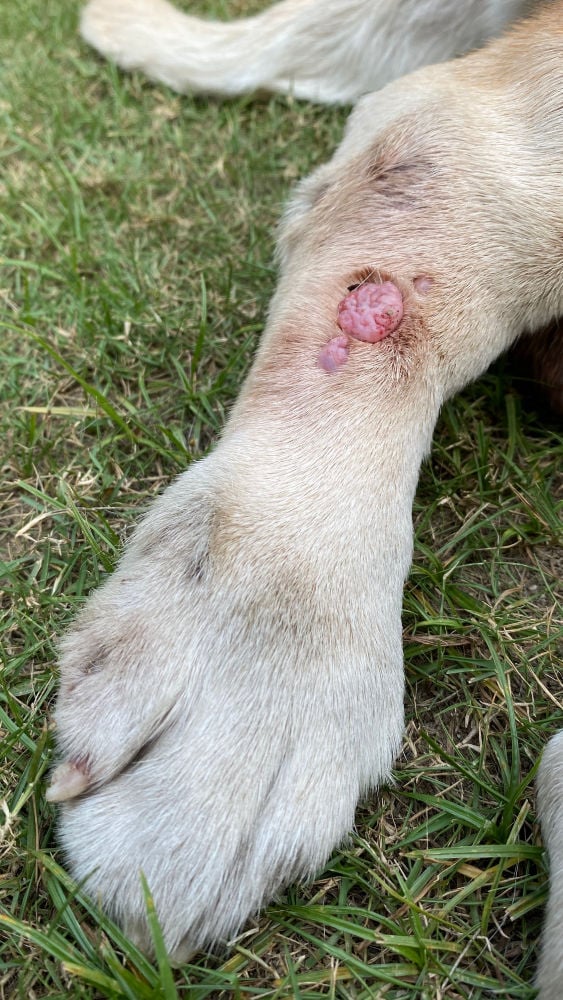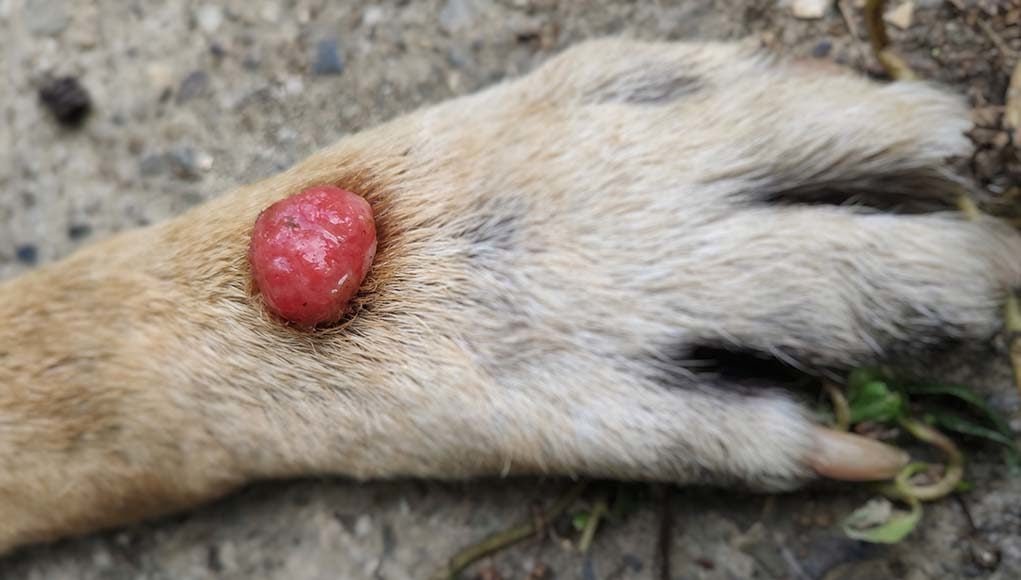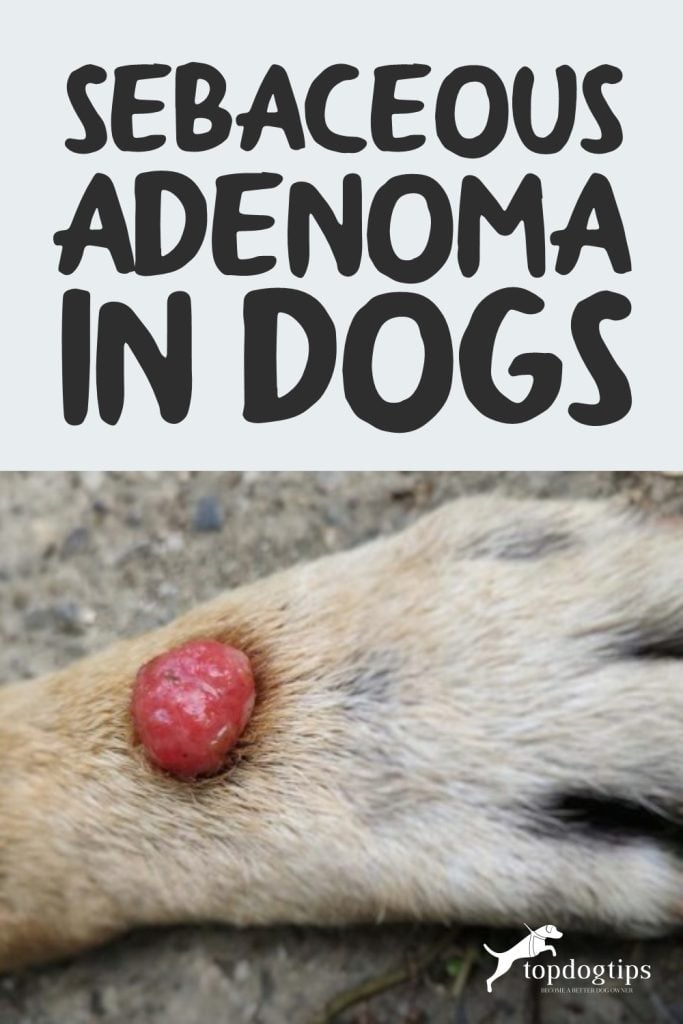Table of Contents
- What Is Sebaceous Adenoma in Dogs?
- What Causes Sebaceous Adenomas in Dogs?
- How Do Sebaceous Adenomas Affect Dogs?
- How Are Sebaceous Adenomas Diagnosed?
- Sebaceous Cyst vs. Sebaceous Adenoma
- Treatment for Sebaceous Adenomas in Dogs
- Common Questions about Sebaceous Gland Tumors in Dogs
- How Do You Treat Sebaceous Adenoma in Dogs?
- Do Sebaceous Adenomas Fall Off Dogs?
- Can a Sebaceous Adenomas in Dogs Grow?
- What Does a Sebaceous Cyst on Dogs Look Like?
- How Do You Get Rid of a Sebaceous Cyst on a Dog?
- What Does Histiocytoma Look Like on Dogs?
- What Does a Papilloma Look Like on a Dog?
- How Do I Get Rid of My Dog’s Skin Growth?
- Sebaceous Adenoma in Dogs – Summary
When you come across a lump, bump, or strange growth on your dog, it can be a scary experience.
The first thought that comes to mind of a dog owner is often “cancer,” but fortunately, dogs generally have no worries about sebaceous adenoma in dogs.
Skin conditions are common in dogs, and many lumps and bumps are entirely harmless.
That said, it is essential to have your dog checked out by a veterinarian either way.
This article will talk about sebaceous adenoma in dogs and provide tips for identifying the problem and what action to take.
In this article, we will discuss:
- What is a sebaceous adenoma?
- What causes a sebaceous adenoma in dogs?
- How do sebaceous adenomas affect dogs?
- How do vets tell if it is a sebaceous adenoma?
- How is a sebaceous cyst different from a sebaceous adenoma?
- What is the treatment for sebaceous adenomas in dogs?

What Is Sebaceous Adenoma in Dogs?
A sebaceous adenoma (or sebaceous gland adenoma) is one of the five types of sebaceous gland tumors on dogs; it’s a non-viral type of cutaneous wart (1).
This means that the dog’s immune system doesn’t affect the mass.
Sebaceous adenomas are essentially benign tumors, which are non-cancerous and aren’t dangerous (2).
It’s the most common type of tumor in dogs (3).
Although they may look and sound scary, like warts, they cause no harm to your dog and can be left alone in most cases.
Occasionally, you will see small tufts of hair growing out of the dog’s sebaceous adenoma, although they are generally hairless protrusions resembling a cauliflower.
They are commonly found in the following areas of a dog’s body (4):
- Head
- Neck
- Back
- Eyelids
- Limbs
You are more likely to see sebaceous adenomas on senior dogs, with an average age between 9 and 10.5 years and with hindquarters, abdomen, and thorax being the most commonly affected areas (5, 6).
Dogs prone to them may develop more of these growths as they get older, too.
What Causes Sebaceous Adenomas in Dogs?
The sebaceous gland is an oil gland in the dog’s skin (7).
It produces an oily substance called sebum, which helps to lubricate the skin.
When it begins to overproduce oil, the gland itself increases in size and can get bigger.
However, it is easy to distinguish a sebaceous adenoma from viral warts due to its oily nature.
When squeezed, a clear or sometimes black-colored oily substance extrudes from the skin pores.
How Do Sebaceous Adenomas Affect Dogs?

Sebaceous adenomas are not dangerous as they are benign and do not usually contain any cancer. T
hey rarely need to be removed, and if left alone, they will often not bother your dog (8).
However, there are a few ways that sebaceous adenomas can affect your dog.
Because they secrete oil, scabs can sometimes form (9).
The area can also become itchy, and if it is bothering your dog, the dog can exacerbate the situation by scratching and causing secondary scabbing.
Sometimes, the sebaceous cyst on a dog is in a tricky location on your dog’s body, causing a problem by either growing too big or being irritated when the dog lies down, eats, or, in some cases, blinks – all depending on where the mass is situated on your dog’s body.
Removal of sebaceous adenomas is usually only considered to improve a dog’s quality of life if they are chewing and licking the area constantly or other problems have developed (10).
How Are Sebaceous Adenomas Diagnosed?
The diagnosis of a sebaceous adenoma on a dog will often depend on the history and examination of the mass (11).
When you take your dog to be checked by a veterinarian, you can expect to be asked some of the following questions:
- How long have you noticed the mass being there?
- How many masses have you found?
- Have you seen any changes in appearance?
- How fast does it seem to be growing?
- Has your dog had any recent injuries or injections?
- Have you seen any other changes in your pet’s behavior?
Your vet will also undertake a physical examination to determine whether or not the mass appears to be attached to the underlying skin or if it is ulcerated, and whether there is a presence of oil or secretion (12).
They will check whether the dog is in pain or discomfort or whether the mass feels hot.
If your veterinarian is not sure that it is a sebaceous adenoma just by looking at it, or if they are not experienced with these growths and prefer to have a second opinion, they may do a fine needle aspiration (13).
If you are unsure about a veterinarian’s diagnosis, you can request them to have this done.
The delicate needle aspiration procedure involves using a very tiny needle to remove cells from the growth. The cells are then sent to a pathologist for an evaluation, and a definite diagnosis can be arrived at.
Sebaceous Cyst vs. Sebaceous Adenoma
Sebaceous cysts in dogs are less common (14). They are thought to develop from an obstruction of the follicles, leading to an abnormal sebum accumulation.
A sebaceous cyst is essentially a tiny sac containing an accumulation of sebum.
Like sebaceous adenomas, these cysts are also benign, non-painful growths, although they can sometimes be tender to touch.
The difference between the two is that one is a cyst, and one is a tumor.
Cysts are sacs of tissue filled with another substance, like air or fluid. Tumors, on the other hand, are solid masses of tissue.
Treatment for Sebaceous Adenomas in Dogs
No treatment is required when the diagnosis is that it’s a sebaceous adenoma (15).
However, there are occasions when the area breaks open and bleeds or has become infected due to rubbing a collar or leash or your dog chewing at it.
Grooming procedures like brushing can also catch and cause a wound in the area. If the sebaceous adenoma is near the dog’s mouth, it may become damaged when the dog is eating.
If it is on the dog’s eyelid, it can lead to other problems, such as rubbing on the eye and causing corneal ulcerations (16).
When the circumstances require it, such as in the incidents described above, the vet can surgically remove the sebaceous adenoma along with a wedge of the underlying skin to ensure that none of it is left behind.
The surgery is usually performed under general anesthesia.
Common Questions about Sebaceous Gland Tumors in Dogs
If you need more information about treating tumors of the sebaceous glands in dogs or want the previous information more concisely, this FAQ should help.
How Do You Treat Sebaceous Adenoma in Dogs?
Most of the time, sebaceous adenomas are purely cosmetic lesions. They do not usually affect your dog’s health, so you do not need to treat them aggressively.
That being said, sebaceous adenomas may irritate your dog. They may also change or grow. When this happens, your vet will want to remove the sebaceous tumors. He will then biopsy them.
The thing to remember is that your dog’s vet can remove the benign tumors. But new ones will likely form. This is particularly true as your dog ages.
Do Sebaceous Adenomas Fall Off Dogs?
Sebaceous adenomas tend not to fall off dogs. However, they are benign growths, so you do not typically need to treat them.
If they irritate your dog, your vet will need to perform surgical removal, as they won’t disappear by themselves.
Can a Sebaceous Adenomas in Dogs Grow?
Once dogs develop sebaceous adenomas, they can grow. However, they typically grow slowly.
Because of this, your vet typically doesn’t recommend removing a sebaceous tumor unless it gets in the way or poses a threat to your dog’s health.
What Does a Sebaceous Cyst on Dogs Look Like?
On dogs, sebaceous cysts are raised bumps. They may be slightly blue, or they may be light.
If they burst, they will ooze discharge similar to cottage cheese, brown, or grayish-white. Most of these skin tumors or cysts develop on your dog’s upper legs, torso, head, or neck.
If the cyst appears dark in color, then it is likely a false cyst. This means that it is filled with blood.
How Do You Get Rid of a Sebaceous Cyst on a Dog?
Whether it is a benign tumor or a rare malignant tumor, surgery is the only method to remove the sebaceous cyst.
That being said, if the tumors occur with an infection, your vet will likely prescribe your dog antibiotics as well.
What Does Histiocytoma Look Like on Dogs?
Histiocytomas typically affect the limbs, ears, neck, or head. They are usually single hairless lumps that are small in size.
Sometimes, more than one will appear at once. This is especially common in Shar Peis.
What Does a Papilloma Look Like on a Dog?
Papillomas on dogs typically have rough surfaces that are almost jagged.
Many people compare their appearance to that of a cauliflower or sea anemone. They are more common on young dogs, especially on the muzzle or lips.
How Do I Get Rid of My Dog’s Skin Growth?
Dog owners can ask vets to use one of several methods to remove skin growth from their dogs. Small ones that aren’t painful are simple to remove.
Your dog may need a local anesthetic. Then, your vet can freeze the growth off or cut it off. Your vet may also use electrocautery or a laser to remove it.
The exact method of removing the skin growth will depend on the type of growth in question.
Sebaceous Adenoma in Dogs – Summary
A professional veterinarian should always check out any lump, bump, or growth on your pet’s body to rule out any serious conditions.
If your dog does have a sebaceous adenoma, you may like to see this as good news, as generally speaking, these do not cause your dog any severe problem, as long as an eye is kept on the situation.














